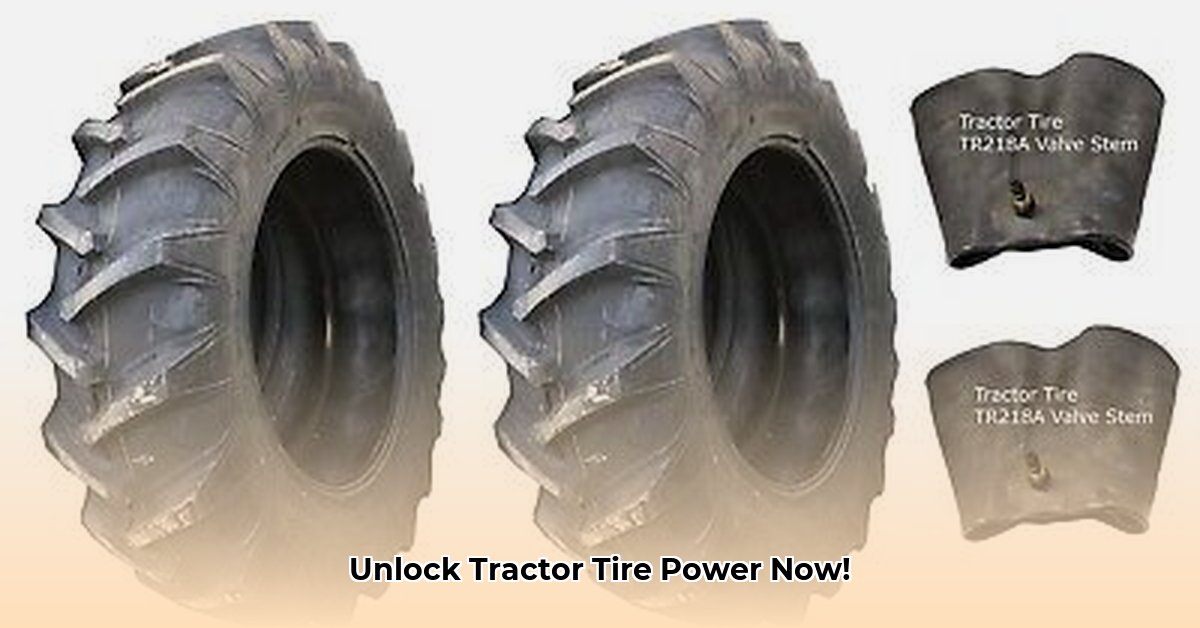
Choosing the right tractor tires significantly impacts farm efficiency and profitability. This guide focuses on 18.4 x 38 tractor tires, a common size, providing insights into market dynamics and actionable strategies for maximizing your investment. For more detailed specifications, check out this helpful resource.
The 18.4 x 38 Tractor Tire Market: A Comprehensive Overview
Demand for 18.4 x 38 tractor tires remains robust. However, a precise market size is difficult to determine due to data fragmentation across various online and offline channels. Price inconsistencies across different sellers suggest underlying supply chain challenges and potential variations in tire quality.
Navigating the 18.4 x 38 Tractor Tire Supply Chain
The journey from raw materials to the farm involves several stages, each presenting potential obstacles impacting timely delivery and ultimately, farm operations.
- Raw Material Volatility: Fluctuations in rubber prices, a key component of tire manufacturing, directly influence the final cost of the product. Manufacturers continuously adapt to these price shifts.
- Distribution Bottlenecks: Efficient distribution is crucial for minimizing delays that can disrupt planting and harvesting schedules. Inefficiencies at this stage impact both farmers and the broader supply chain.
- Price Transparency: Inconsistent pricing across different suppliers hinders fair price comparisons. Increased transparency is needed to ensure fair pricing and avoid exploitation.
Actionable Strategies for Stakeholders
Understanding the complexities of the 18.4 x 38 tractor tire market requires a multi-faceted approach. All stakeholders play a critical role in optimizing the system and ensuring sustainable agricultural practices.
1. Tire Manufacturers: Streamline production processes to improve consistency and establish more transparent pricing models. Invest in research and development, exploring sustainable rubber alternatives and technologies for predictive tire maintenance.
2. Agricultural Retailers: Implement robust inventory management to consistently meet farmer demand. Enhance online platforms to provide comprehensive and transparent product information including pricing. Develop value-added services, such as tire fitting and maintenance packages.
3. Farmers: Actively compare prices from multiple suppliers. Prioritize quality over solely the lowest price, considering the total cost of ownership (TCO) throughout the tire's lifespan. Invest in proper tire maintenance to maximize lifespan and performance.
4. Government Agencies: Fund research initiatives focusing on environmentally friendly tire manufacturing and disposal methods. Promote policies that encourage responsible manufacturing practices and sustainable tire lifecycle management.
Maximizing Your 18.4 x 38 Tire Investment: A Practical Guide
Farmers must consider several key factors to ensure maximum ROI from their tire investment:
- Prioritize Quality: Higher-quality tires, while initially more expensive, offer superior longevity, reducing the overall cost per acre farmed.
- Select Reliable Suppliers: Choose vendors with a proven track record of reliability and customer service to ensure timely support whenever needed.
- Analyze Total Cost of Ownership: Calculate the complete cost encompassing the initial purchase, expected lifespan, potential repairs, and eventual replacement. This holistic approach helps in making informed purchasing decisions.
The Path to Sustainability: Environmental Considerations in Tire Manufacturing
The future of 18.4 x 38 tractor tires, and indeed the entire tire industry, is intrinsically linked to environmental sustainability. Manufacturers are increasingly investing in bio-based rubber and other eco-friendly materials, reducing the environmental impact of tire production. Government regulations are also playing a crucial role—pushing for responsible manufacturing and end-of-life tire disposal strategies. These changes are essential not only for environmental protection but also for the long-term viability of agriculture.
"The integration of sustainable practices into tire manufacturing is no longer a choice but a necessity," says Dr. Anya Sharma, Professor of Sustainable Materials Science, University of California, Berkeley. "The transition to bio-based materials offers a significant opportunity to lessen agriculture's environmental footprint and ensure the long-term viability of the industry."
Do you recognize the importance of sustainable practices in your tire purchasing decisions?
This shift towards sustainability is creating significant opportunities for innovation and growth in this sector. Many manufacturers are embracing the challenge, positioning themselves for the future of environmentally responsible agriculture.
Comparing 18.4-38 Agricultural Tire Prices and Quality
Choosing the right tire requires careful evaluation beyond just price, encompassing the larger issues of efficiency and yield.
Brand Comparison: Michelin, Firestone, and budget alternatives
Michelin and Firestone occupy the premium segment, offering superior performance but at a higher price. Alternatives from Trelleborg, BKT, and Mitas provide cost-effective options with varying performance levels. Goodyear’s offerings merit cautious evaluation due to inconsistent user feedback.
Key Factors to Consider:
- Tread Life: Assess projected lifespan, weighing initial cost against long-term cost per hour of operation.
- Traction: Consider the soil conditions on your farm. Deep tread is best for mud, while radial designs perform better on solid surfaces.
- Ride Comfort: Heavier sidewalls may increase durability but potentially compromise ride comfort.
- Warranty & Maintenance: A robust warranty reflects manufacturer confidence, while regular maintenance is crucial regardless of the brand.
A Step-by-Step Guide to Informed Tire Purchasing:
- Assess Farming Needs: Consider soil conditions and annual operational hours.
- Research Brands: Explore user reviews and compare farmer experiences with different brands.
- Compare Specifications: Go beyond price; compare tread depth, construction, and warranty details.
- Obtain Multiple Quotes: Shop around to obtain competitive pricing from multiple sources.
- Verify Tractor Compatibility: Check your tractor's manual to ensure tire size and rim compatibility.
This comprehensive approach to evaluating 18.4 x 38 tractor tires enables farmers to make informed decisions, ensuring optimal performance and cost-effectiveness. Remember, investing in quality tires is an investment in the future of your farm.